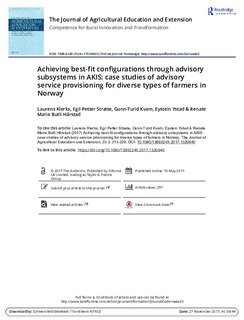| dc.contributor.author | Klerkx, Laurens | |
| dc.contributor.author | Stræte, Egil Petter | |
| dc.contributor.author | Kvam, Gunn-Turid | |
| dc.contributor.author | Ystad, Eystein | |
| dc.contributor.author | Hårstad, Renate Marie Butli | |
| dc.coverage.spatial | Norway | nb_NO |
| dc.date.accessioned | 2018-04-10T11:47:36Z | |
| dc.date.available | 2018-04-10T11:47:36Z | |
| dc.date.created | 2017-05-11T12:30:14Z | |
| dc.date.issued | 2017-05-10 | |
| dc.identifier.citation | The Journal of Agricultural Education and Extension. 2017, 23 (3), 213-229. | nb_NO |
| dc.identifier.issn | 1389-224X | |
| dc.identifier.uri | http://hdl.handle.net/11250/2493434 | |
| dc.description.abstract | Purpose: In light of the discussion on ‘best-fit’ in pluralistic advisory
systems, this article aims to present and discuss challenges for
advisory services in serving various types of farmers when they
seek and acquire farm business advice.
Design/methodology/approach: The empirical basis is data
derived from four workshops, five interviews with staff from
advisory organizations, and interviews with 11 farmers.
Findings: Emerging configurations serve different types of farmers,
that is, private advisors serve different clients in different ways;
these could be considered subsystems within the overall advisory
system.
Practical implications: Best-fit configurations of advisory services
exist within a country setting in response to farmers’ information
demands and how they seek information, as well as public goals
of the advisory system, and lead to advisory subsystems. Policymakers
should monitor the emergence of these subsystems and
become active participants in some of them, in line with the
concept of the public sector as regulator of private and
commercial advisory systems.
Theoretical implications: Best-fit has been mainly explored at
country level, but this study shows that, within countries, different
advisory service configurations are formed. So, best-fit should not
be considered at national level only, in view of subsystems which
can have wider or narrower boundaries. More broadly, the
concept of Agricultural Knowledge and Innovation Systems (AKIS)
should not be confined to the national level, for example, in view
of farmer specializations within countries and the international
dimensions of advisory systems.
Originality/value: The originality lies in the further unraveling of
heterogeneity within AKIS and what this implies for advisory
service delivery configurations. | nb_NO |
| dc.language.iso | eng | nb_NO |
| dc.publisher | Taylor & Francis | nb_NO |
| dc.rights | Attribution-NonCommercial-NoDerivatives 4.0 Internasjonal | * |
| dc.rights.uri | http://creativecommons.org/licenses/by-nc-nd/4.0/deed.no | * |
| dc.subject | Advisory services | nb_NO |
| dc.subject | AKIS | nb_NO |
| dc.subject | transformation | nb_NO |
| dc.subject | extension | nb_NO |
| dc.subject | farming styles | nb_NO |
| dc.title | Achieving best-fit configurations through advisory subsystems in AKIS: case studies of advisory service provisioning for diverse types of farmers in Norway | nb_NO |
| dc.type | Journal article | nb_NO |
| dc.type | Peer reviewed | nb_NO |
| dc.description.version | publishedVersion | nb_NO |
| dc.rights.holder | © 2017 The Author(s). Published by Informa UK Limited, trading as Taylor & Francis Group | nb_NO |
| dc.source.pagenumber | 213-229 | nb_NO |
| dc.source.volume | 23 | nb_NO |
| dc.source.journal | The Journal of Agricultural Education and Extension | nb_NO |
| dc.source.issue | 3 | nb_NO |
| dc.identifier.doi | 10.1080/1389224X.2017.1320640 | |
| dc.identifier.cristin | 1469602 | |
| dc.relation.project | Norges forskningsråd: 244138 | nb_NO |
| cristin.ispublished | true | |
| cristin.fulltext | original | |
| cristin.qualitycode | 2 | |

